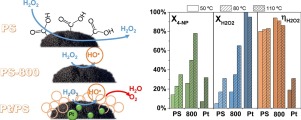Catalysis Today ( IF 5.2 ) Pub Date : 2018-01-03 , DOI: 10.1016/j.cattod.2018.01.003 Maria Martin-Martinez , Silvia Álvarez-Torrellas , Juan García , Adrián M.T. Silva , Joaquim L. Faria , Helder T. Gomes

|
Peach stones were used as raw material for the synthesis of activated carbons with different properties. Firstly, peach stones were chemically activated using a 12 M H3PO4 solution and carbonized under flowing air (400 °C). The obtained activated carbon, named as PS, is characterized by a high surface development (SBET = 1262 m2 g−1) and acidic character (pHPZC = 4.2). A fraction of PS was further carbonized under N2 atmosphere at 800 °C to remove surface functionalities and to increase its basicity (PS-800). In addition, a Pt catalyst supported on PS (3% w/w Pt/PS) was synthesized by incipient wetness impregnation, resulting in a considerable hydrophilicity increasing. The synthesized materials were tested in the catalytic wet peroxide oxidation (CWPO) of highly concentrated solutions of 4-nitrophenol (4-NP, 5 g L−1) during 24 h experiments, conducted at relatively mild operating conditions (T = 50–110 °C, pH = 3, catalyst load = 2.5 g L−1 and [H2O2]0 = 17.8 g L−1, corresponding to the stoichiometric amount of H2O2 needed for the complete mineralization of 4-NP). It was observed that the increase of electron-donating functionalities in PS-800 promotes the generation of reactive HO radicals, being the activity towards CWPO twice higher than that obtained with the pristine PS. Besides, increasing operating temperature substantially enhances CWPO, finding a 80% of 4-NP removal at 110 °C. On the other hand, despite the sharp increment in H2O2 decomposition due to the presence of Pt particles in Pt/PS catalyst, this decomposition is inefficient in all cases, with a consequent poor pollutant removal. This can be attributed to the recombination of HO
radicals into non-reactive species −scavenging effects, promoted by the hydrophilicity of the catalyst.
中文翻译:

探索桃石合成的化学活性炭作为湿式过氧化物氧化的无金属催化剂的活性
桃石被用作合成具有不同性质的活性炭的原料。首先,使用12 MH 3 PO 4溶液对桃石进行化学活化,然后在流动的空气中(400°C)将其碳化。获得的称为PS的活性炭的特征在于高的表面显影性(S BET = 1262m 2 g -1)和酸性特征(pH PZC = 4.2)。一部分PS在N 2下进一步碳化在800°C的大气压下去除表面功能并增加其碱度(PS-800)。另外,通过初期湿润浸渍来合成负载在PS上的Pt催化剂(3%w / w Pt / PS),导致亲水性显着提高。在相对温和的操作条件下(T = 50-110),在24小时的实验过程中,对高浓度的4-硝基苯酚(4-NP,5 g L -1)的溶液进行湿法催化湿式过氧化氧化(CWPO)进行了测试°C,pH = 3,催化剂负载= 2.5 g L -1,[H 2 O 2 ] 0 = 17.8 g L -1,对应于H 2 O 2的化学计量是4-NP完全矿化所必需的)。观察到,PS-800中供电子功能的增加促进了反应性HO自由基的生成,这是对CWPO的活性比原始PS所获得的活性高两倍。此外,提高工作温度可显着提高CWPO,在110°C时可去除80%的4-NP。另一方面,尽管由于在Pt / PS催化剂中存在Pt颗粒而导致H 2 O 2分解急剧增加,但是这种分解在所有情况下都是无效的,因此污染物去除较差。这可以归因于
由催化剂的亲水性促进的HO基团重组为非反应性物种-清除作用。











































 京公网安备 11010802027423号
京公网安备 11010802027423号